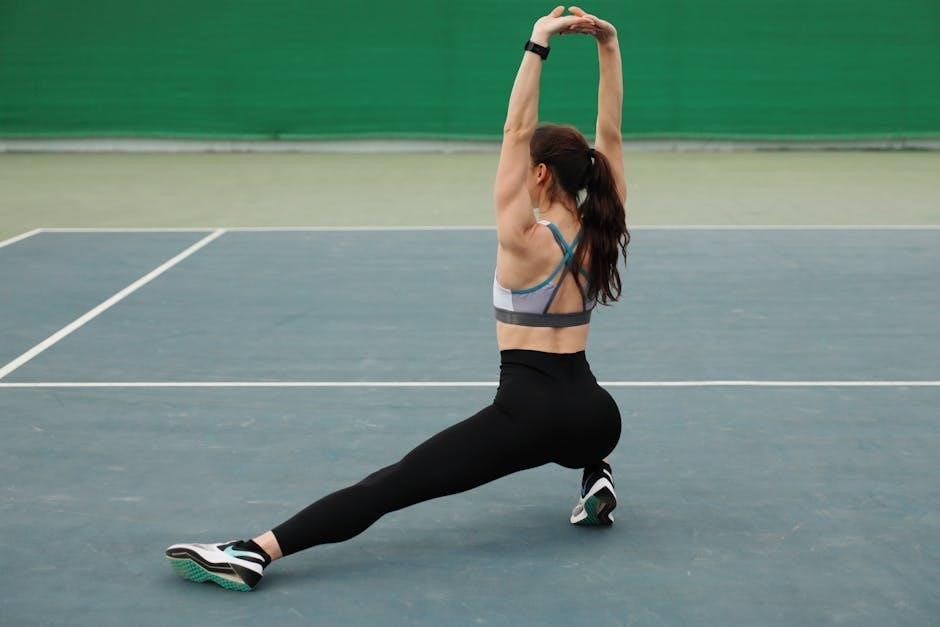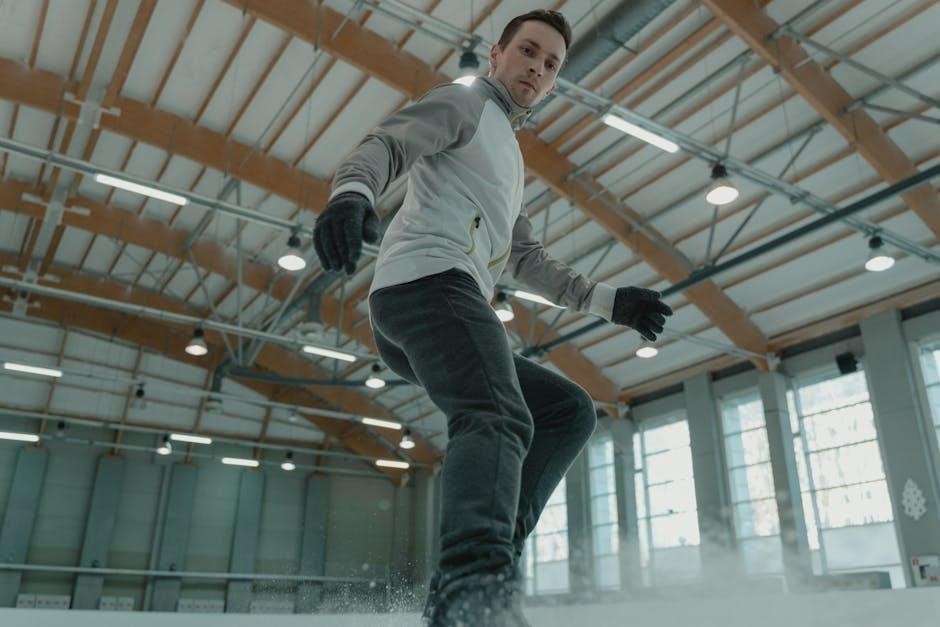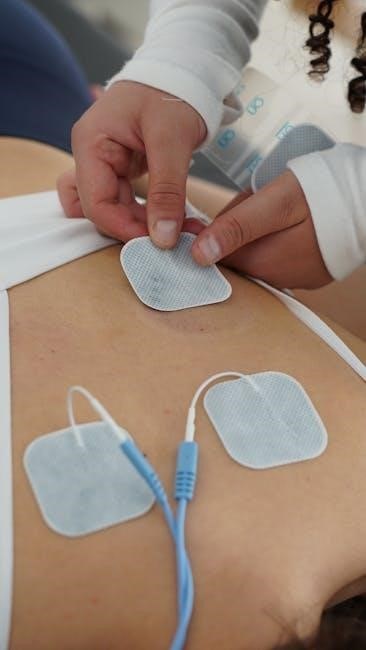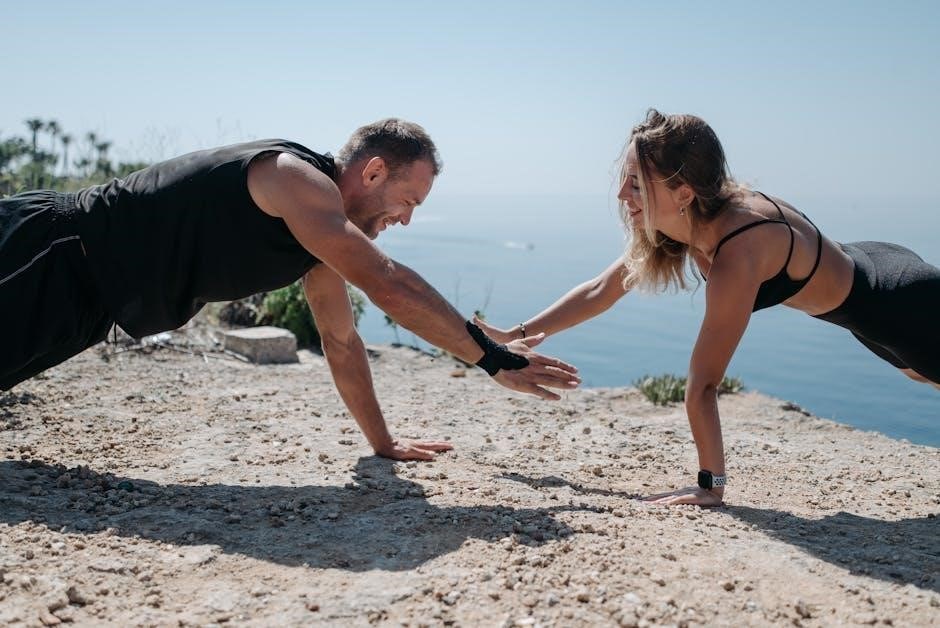
Inguinal hernias occur when tissue protrudes through a weak spot in the abdominal wall, often causing discomfort. Exercises play a crucial role in managing symptoms, improving recovery, and preventing recurrence. While they cannot cure hernias, strengthening the core, pelvic floor, and abdominal muscles can alleviate strain and support surgical recovery. Gentle stretches and low-impact activities, such as walking, are recommended to promote healing and maintain flexibility without exacerbating the condition. This guide outlines effective exercises tailored to individuals with inguinal hernias, focusing on posture, stability, and gradual strengthening.
1.1 Overview of Inguinal Hernia and Its Management
An inguinal hernia occurs when tissue, such as part of the intestine, protrudes through a weak spot in the abdominal wall, typically in the groin area. It is a common condition that can cause discomfort, swelling, and pain, especially during physical activity. Hernias are classified into types, including direct and indirect inguinal hernias, based on their location and cause. Management strategies often involve a combination of lifestyle modifications, medical interventions, and surgical repair. Early diagnosis and appropriate care are essential to prevent complications such as strangulation or obstruction. While surgery is the definitive treatment, non-surgical approaches like exercise and bracing may help manage symptoms in some cases. Understanding the condition is key to effective treatment and recovery.
1.2 Importance of Exercise in Hernia Recovery and Prevention

Exercise plays a vital role in the recovery and prevention of inguinal hernias by strengthening the abdominal and pelvic floor muscles, which helps reduce strain on the hernia site. Post-surgery, gentle exercises promote healing, improve mobility, and prevent recurrence. Activities like walking, core strengthening, and Pilates-based movements are particularly beneficial as they enhance posture and muscle interaction without putting excessive pressure on the abdominal wall. Consistent exercise also boosts overall physical stability, reducing the risk of future hernias. However, it’s crucial to avoid heavy lifting or high-impact activities that could worsen the condition. A tailored exercise routine, guided by healthcare professionals, ensures safe and effective management of inguinal hernias.
Types of Exercises for Inguinal Hernia
This section focuses on three main types of exercises for managing inguinal hernias: core strengthening to stabilize the abdomen, pelvic floor exercises like Kegels to enhance muscle support, and gentle stretching to improve flexibility and reduce discomfort.
2.1 Core Strengthening Exercises
Core strengthening exercises are essential for stabilizing the abdomen and supporting the area affected by an inguinal hernia. These exercises focus on improving the strength and endurance of the transverse abdominis muscle, which plays a key role in maintaining abdominal stability. Techniques such as Pilates-based exercises, including the “hundred” and “plank,” are highly recommended. Additionally, exercises like bird-dog and pelvic tilts can help enhance core stability without putting excessive strain on the hernia site. Proper breathing and controlled movements are emphasized to avoid discomfort or protrusion. Strengthening the core helps reduce pressure on the inguinal canal, promoting healing and preventing further complications. Regular practice of these exercises can significantly improve overall abdominal strength and support.
2.2 Pelvic Floor Strengthening Techniques
Pelvic floor strengthening techniques are vital for managing inguinal hernias, as they help stabilize the pelvic area and reduce pressure on the hernia site. Kegel exercises are a cornerstone of pelvic floor training, involving the contraction and release of the muscles used to stop urination. These exercises can be performed lying down, sitting, or standing, and should be done in sets of 10-15 repetitions, 3-4 times daily. Proper posture during these exercises ensures effectiveness. Techniques like the “Pillow Squeeze” also engage the pelvic floor muscles by squeezing a pillow between the knees while lying flat. Strengthening these muscles improves overall pelvic stability, reduces discomfort, and supports hernia recovery. Regular practice can significantly enhance muscle tone and provide long-term benefits for hernia management and prevention.
2.3 Gentle Stretching and Mobility Exercises
Gentle stretching and mobility exercises are essential for maintaining flexibility and reducing muscle tension around the hernia site. These exercises focus on the adductor, hamstring, and quadriceps muscles, which play a crucial role in groin and pelvic stability. Techniques such as adductor stretches, hamstring stretches, and hip rotations can be performed while sitting, standing, or lying down. Additionally, trunk rotations and self-adductor stretches (e.g., FABER stretch) are recommended to improve mobility without straining the hernia site; These exercises should be done gently, ideally every 2-3 hours, to prevent stiffness and promote blood flow. Breathing techniques, such as exhaling during the exertion phase, can enhance relaxation and effectiveness. Avoiding heavy lifting or high-impact activities is crucial during this phase to protect the hernia site.

Post-Surgical Recovery Exercises
Post-surgical recovery exercises are tailored to promote healing, manage pain, and gradually restore strength. They focus on light activities, such as walking and gentle stretching, while avoiding heavy lifting or strenuous movements to protect the hernia repair.

3.1 Immediate Post-Operative Phase (0-2 Weeks)
The immediate post-operative phase focuses on wound healing, pain management, and preventing complications. Gentle exercises such as walking (15 minutes, twice daily) and ankle pumps are recommended to improve circulation without straining the repair site. Patients should avoid activities that cause discomfort or increase intra-abdominal pressure, such as heavy lifting or coughing forcefully. Trunk rotations and gentle stretches for the adductor, hamstring, and quadriceps muscles can help maintain flexibility. Pain control measures, including cryotherapy and electrical muscle stimulation, may be used. It’s crucial to ensure the hernia site remains flat during exercises, with no protrusion. Patients should progress only if they meet specific criteria, such as reduced pain and improved mobility.
3.2 Strengthening Exercises (2-6 Weeks After Surgery)
During this phase, patients focus on rebuilding strength and stability. Gentle strengthening exercises, such as glute squeezes and sit-to-stand movements, are introduced to improve core stability without straining the repair site. Pelvic floor exercises, like pillow squeezes, are also recommended to enhance muscle tone. Patients are advised to perform 3 sets of 10 repetitions for each exercise, ensuring slow and controlled movements to avoid discomfort. Activities like single-arm shoulder flexion and trunk rotations are incorporated to improve mobility and strength. It’s important to avoid exercises that cause pain beyond a mild level, using a pain scale to guide intensity. These exercises aim to restore functional strength and prepare for gradual return to daily activities.

Preventing Hernia Recurrence Through Exercise
Strengthening core and pelvic floor muscles through targeted exercises helps prevent hernia recurrence. Proper posture, avoiding heavy lifting, and incorporating low-impact activities like walking are essential for long-term management.
4.1 Lifestyle Modifications and Activity Guidelines

Lifestyle modifications are essential for preventing hernia recurrence. Avoid heavy lifting, bending, or activities that strain abdominal muscles. Maintain a healthy weight to reduce pressure on the groin area. Opt for a balanced diet rich in fiber to prevent constipation, which can worsen hernias. Incorporate gentle exercises like walking or swimming to improve core strength without overexertion. Avoid tight clothing that restricts movement or increases intra-abdominal pressure. Good posture can reduce strain on the abdominal wall. Limit activities that involve repetitive twisting or heavy lifting. Prioritize low-impact exercises and avoid vigorous abdominal workouts. Consulting a healthcare provider or physical therapist can help tailor activities to individual needs and ensure safe exercise practices.
4.2 Avoiding Exercises That May Worsen the Condition
Certain exercises can exacerbate an inguinal hernia by increasing intra-abdominal pressure. Avoid heavy lifting, high-impact sports, and repetitive bending. Activities like aggressive abdominal crunches or sit-ups should be avoided, as they strain the abdominal wall. High-intensity workouts, such as vigorous Pilates or weightlifting, may also worsen symptoms. Overexertion in exercises like cycling or running can increase pressure on the groin area. Pain should guide activity levels; if an exercise causes discomfort beyond mild pain, it should be stopped or modified. Consulting a healthcare provider or physical therapist can help identify safe alternatives and prevent further complications. Prioritizing low-impact activities and gentle stretches is crucial to avoid aggravating the condition.
Inguinal hernia exercises are vital for managing symptoms, enhancing recovery, and preventing recurrence. Consistent practice of core strengthening, pelvic floor stability, and gentle stretches promotes long-term well-being and reduces discomfort effectively.
5.1 Summary of Key Exercises and Best Practices

The most effective exercises for managing inguinal hernias include gentle stretches, pelvic tilts, and core-strengthening movements like bridges and planks. Walking and deep breathing exercises also promote healing. Postural awareness is crucial to reduce strain on the abdominal wall. Avoid heavy lifting, high-impact activities, and exercises that cause discomfort or protrusion. Gradually progress strength training, focusing on controlled movements. Use a hernia support belt if recommended. Consistency is key to improving muscle stability and preventing recurrence. Always consult a healthcare provider before starting new routines, especially post-surgery. Combining these practices with lifestyle modifications ensures optimal recovery and long-term hernia management.